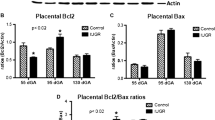Abstract.
The adriamycin rat model (ARM) exhibits many features of the VACTERL association. Adriamycin is a cytotoxic drug used in cancer chemotherapy. Although its exact mode of action is not clear, it is presumed to have a similar cytotoxic role in the developing embryo. Lysotracker red (LT) is a dye that stains phagolysosomes and apoptotic bodies and allows entire rodent embryos to be stained for apoptosis. We hypothesised that there was increased cell death in adriamycin-exposed embryos. To investigate this hypothesis, adriamycin (1.75 mg/kg) was given intraperitoneally to rats on days 7, 8, and 9 of pregnancy. A control group was given saline on the same schedule. Embryos were recovered at 3, 12, 24, and 48 h following the last dose and also at term (21 days) to confirm that the usual incidence of congenital anomalies found in the ARM was obtained in our animal model. Embryos were embedded in resin, sectioned, and studied by light microscopy. Embryos from the 3-h and 24-h groups were studied using LT and confocal microscopy to search for evidence of apoptosis. All term newborns (100%) from the adriamycin-treated group demonstrated the typical abnormalities found in the ARM, i.e., oesophageal atresia, multiple gastrointestinal atresias, vertebral malformations, absent tails, ureterohydronephrosis, etc. In the 9.5-day adriamycin group there was no difference in appearance between the experimental and control embryos. Specifically, no cellular debris or increased cell turnover indicative of adriamycin cytotoxicity was observed in the experimental group. At day 10.5, 90% of embryos from two separate litters had evidence of notochordal distortion and tethering to the gut or gut-tube abnormalities. These findings were not observed in the control embryos. Confocal microscopy and LT examination of the embryos from litters killed at 3 and 24 h following the last dose of adriamycin demonstrated no evidence of increased cell death in adriamycin-exposed embryos compared to control embryos. The absence of significant apoptosis in the developing embryos in the immediate period following administration of adriamycin suggests that the teratogenic effect of adriamycin is not caused by cell death.
Similar content being viewed by others
Author information
Authors and Affiliations
Additional information
Electronic Publication
Rights and permissions
About this article
Cite this article
Gillick, .J., Giles, .S., Bannigan, .J. et al. Cell death in the early adriamycin rat model. Ped Surgery Int 18, 576–580 (2002). https://doi.org/10.1007/s00383-002-0859-3
Accepted:
Issue Date:
DOI: https://doi.org/10.1007/s00383-002-0859-3




